高考英语阅读理解综合题汇编含详细答案
- 格式:doc
- 大小:181.00 KB
- 文档页数:29
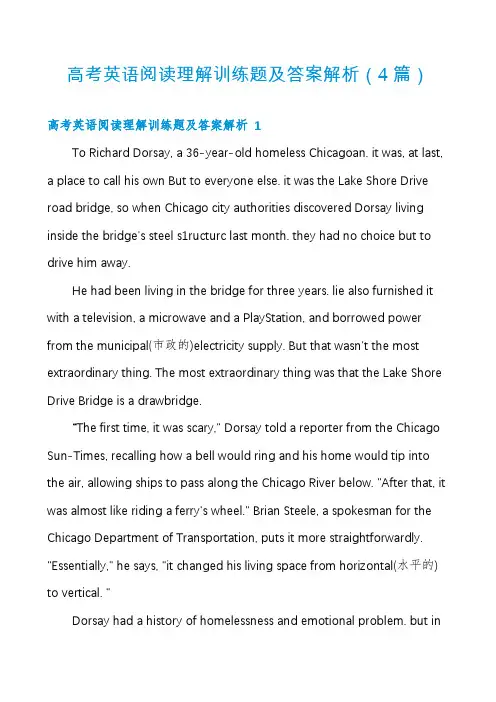
高考英语阅读理解训练题及答案解析(4篇)高考英语阅读理解训练题及答案解析 1To Richard Dorsay, a 36-year-old homeless Chicagoan. it was, at last, a place to call his own But to everyone else. it was the Lake Shore Drive road bridge, so when Chicago city authorities discovered Dorsay living inside the bridge's steel s1ructurc last month. they had no choice but to drive him away.He had been living in the bridge for three years. lie also furnished it with a television, a microwave and a PlayStation, and borrowed power from the municipal(市政的)electricity supply. But that wasn't the most extraordinary thing. The most extraordinary thing was that the Lake Shore Drive Bridge is a drawbridge.“The first time, it was scary," Dorsay told a reporter from the Chicago Sun-Times, recalling how a bell would ring and his home would tip into the air, allowing ships to pass along the Chicago River below. "After that, it was almost like riding a ferry's wheel." Brian Steele, a spokesman for the Chicago Department of Transportation, puts it more straightforwardly. "Essentially," he says, "it changed his living space from horizontal(水平的) to vertical. "Dorsay had a history of homelessness and emotional problem. but inthe bridge. he thought, he had finally found a kind of stability. "You've got to be kind of agile(敏捷的)," he admitted. "But it doesn't take genius to figure out what to do. " Dorsay is now without a home, though he is currently staying with his parents. Gary, his father, said,"I've always hoped that he would find a place and he would seek employment. He is strong enough and bright enough to do something."(B) 24. According to Richard Dorsay, why did he like living in the bridge?A. It was free.B. He felt more secure there.C. It was an extraordinary thing.D. He liked scary things.推理题。
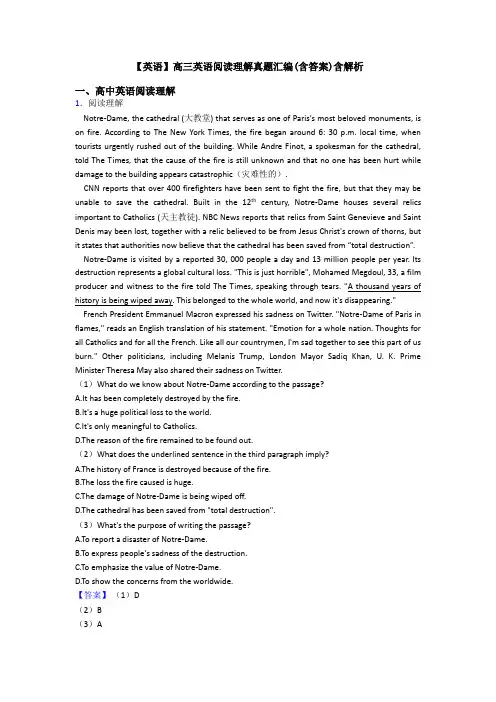
【英语】高三英语阅读理解真题汇编(含答案)含解析一、高中英语阅读理解1.阅读理解Notre-Dame, the cathedral (大教堂) that serves as one of Paris's most beloved monuments, is on fire. According to The New York Times, the fire began around 6: 30 p.m. local time, when tourists urgently rushed out of the building. While Andre Finot, a spokesman for the cathedral, told The Times, that the cause of the fire is still unknown and that no one has been hurt while damage to the building appears catastrophic(灾难性的).CNN reports that over 400 firefighters have been sent to fight the fire, but that they may be unable to save the cathedral. Built in the 12th century, Notre-Dame houses several relics important to Catholics (天主教徒). NBC News reports that relics from Saint Genevieve and Saint Denis may been lost, together with a relic believed to be from Jesus Christ's crown of thorns, but it states that authorities now believe that the cathedral has been saved from “total destruction”. Notre-Dame is visited by a reported 30, 000 people a day and 13 million people per year. Its destruction represents a global cultural loss. "This is just horrible", Mohamed Megdoul, 33, a film producer and witness to the fire told The Times, speaking through tears. "A thousand years of history is being wiped away. This belonged to the whole world, and now it's disappearing."French President Emmanuel Macron expressed his sadness on Twitter. "Notre-Dame of Paris in flames," reads an English translation of his statement. "Emotion for a whole nation. Thoughts for all Catholics and for all the French. Like all our countrymen, I'm sad together to see this part of us burn." Other politicians, including Melanis Trump, London Mayor Sadiq Khan, U. K. Prime Minister Theresa May also shared their sadness on Twitter.(1)What do we know about Notre-Dame according to the passage?A.It has been completely destroyed by the fire.B.It's a huge political loss to the world.C.It's only meaningful to Catholics.D.The reason of the fire remained to be found out.(2)What does the underlined sentence in the third paragraph imply?A.The history of France is destroyed because of the fire.B.The loss the fire caused is huge.C.The damage of Notre-Dame is being wiped off.D.The cathedral has been saved from "total destruction".(3)What's the purpose of writing the passage?A.To report a disaster of Notre-Dame.B.To express people's sadness of the destruction.C.To emphasize the value of Notre-Dame.D.To show the concerns from the worldwide.【答案】(1)D(2)B(3)A【解析】【分析】本文是一篇新闻报道,报道了举世闻名的法国巴黎圣母院发生火灾的相关信息。
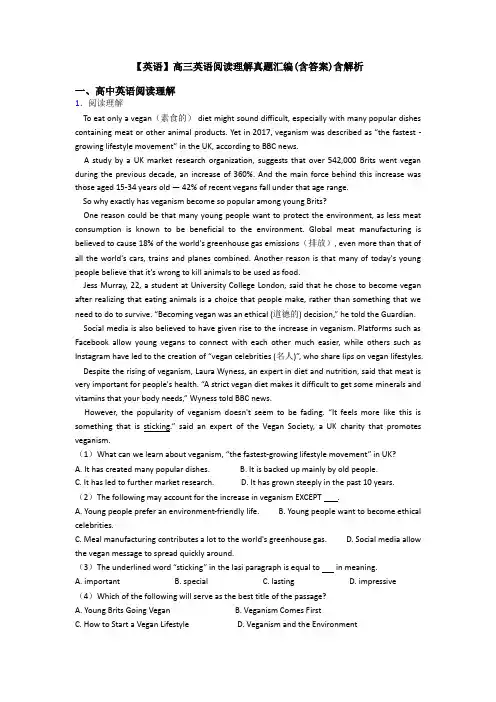
【英语】高三英语阅读理解真题汇编(含答案)含解析一、高中英语阅读理解1.阅读理解To eat only a vegan(素食的) diet might sound difficult, especially with many popular dishes containing meat or other animal products. Yet in 2017, veganism was described as “the fastest - growing lifestyle movem ent” in the UK, according to BBC news.A study by a UK market research organization, suggests that over 542,000 Brits went vegan during the previous decade, an increase of 360%. And the main force behind this increase was those aged 15-34 years old — 42% of recent vegans fall under that age range.So why exactly has veganism become so popular among young Brits?One reason could be that many young people want to protect the environment, as less meat consumption is known to be beneficial to the environment. Global meat manufacturing is believed to cause 18% of the world's greenhouse gas emissions(排放), even more than that of all the world's cars, trains and planes combined. Another reason is that many of today's young people believe that it's wrong to kill animals to be used as food.Jess Murray, 22, a student at University College London, said that he chose to become vegan after realizing that eating animals is a choice that people make, rather than something that we need to do to survive. “Becoming vegan was an ethica l (道德的) decision,” he told the Guardian. Social media is also believed to have given rise to the increase in veganism. Platforms such as Facebook allow young vegans to connect with each other much easier, while others such as Instagram have led to the creation of “vegan celebrities (名人)”, who share lips on vegan lifestyles. Despite the rising of veganism, Laura Wyness, an expert in diet and nutrition, said that meat is very important for people's health. “A strict vegan diet makes it difficult to ge t some minerals and vitamins that your body needs,” Wyness told BBC news.However, the popularity of veganism doesn't seem to be fading. “It feels more like this is something that is sticking.” said an expert of the Vegan Society, a UK charity that pro motes veganism.(1)What can we learn about veganism, “the fastest-growing lifestyle movement” in UK?A. It has created many popular dishes.B. It is backed up mainly by old people.C. It has led to further market research.D. It has grown steeply in the past 10 years.(2)The following may account for the increase in veganism EXCEPT .A. Young people prefer an environment-friendly life.B. Young people want to become ethical celebrities.C. Meal manufacturing contributes a lot to the world's greenhouse gas.D. Social media allow the vegan message to spread quickly around.(3)The underlined word “sticking” in the Iasi paragraph is equal to in meaning.A. importantB. specialC. lastingD. impressive(4)Which of the following will serve as the best title of the passage?A. Young Brits Going VeganB. Veganism Comes FirstC. How to Start a Vegan LifestyleD. Veganism and the Environment【答案】(1)D(2)B(3)C(4)A【解析】【分析】本文是一篇说明文,研究表明,过去的十年里素食主义在英国增长迅猛。
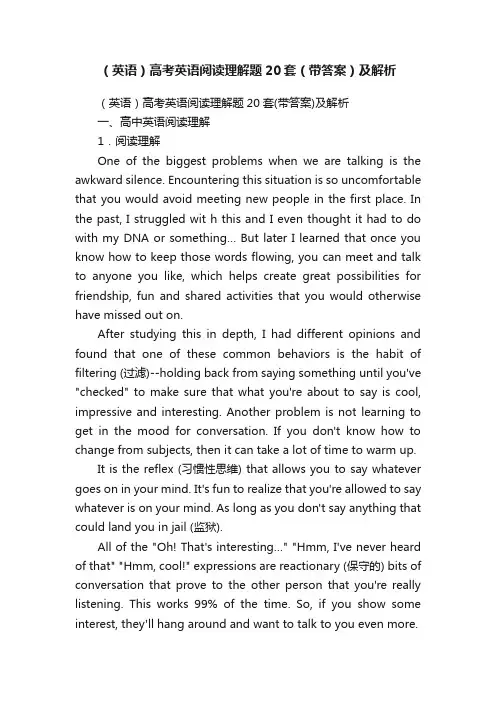
(英语)高考英语阅读理解题20套(带答案)及解析(英语)高考英语阅读理解题20套(带答案)及解析一、高中英语阅读理解1.阅读理解One of the biggest problems when we are talking is the awkward silence. Encountering this situation is so uncomfortable that you would avoid meeting new people in the first place. In the past, I struggled wit h this and I even thought it had to do with my DNA or something… But later I learned that once you know how to keep those words flowing, you can meet and talk to anyone you like, which helps create great possibilities for friendship, fun and shared activities that you would otherwise have missed out on.After studying this in depth, I had different opinions and found that one of these common behaviors is the habit of filtering (过滤)--holding back from saying something until you've "checked" to make sure that what you're about to say is cool, impressive and interesting. Another problem is not learning to get in the mood for conversation. If you don't know how to change from subjects, then it can take a lot of time to warm up.It is the reflex (习惯性思维) that allows you to say whatever goes on in your mind. It's fun to realize that you're allowed to say whatever is on your mind. As long as you don't say anything that could land you in jail (监狱).All of the "Oh! That's interesting…" "Hmm, I've never heard of that" "Hmm, cool!" expressions are reactionary (保守的) bits of conversation that prove to the other person that you're really listening. This works 99% of the time. So, if you show some interest, they'll hang around and want to talk to you even more.Everyone knows that stories juice-up conversations, but most people only talk about stories of their own lives. When someone mentions something related to any of them, just tell the story, even if it's not from your life. The more interesting, stranger or more frightening they are, the harder they are to forget.(1)If people can deal with the awkward silence, they can .A. train their working skillB. improve their life qualityC. enrich their social lifeD. establish their working relationship(2)When talking with others, we should .A. feel nervousB. think twiceC. be free to expressD. avoid breaking in (3)According to the passage, what do the speakers care much about?A. The attractive topics of conversation.B. The atmosphere of the conversation.C. The listener's experiences and tastes.D. The listener's curiosity and concern.(4)What does the underlined part "juice-up conversations" mean?A. making conversations more boringB. making conversations livelierC. making conversations smootherD. making conversations more relaxing【答案】(1)C(2)C(3)D(4)B【解析】【分析】本文本文是一篇议论文,我们谈话时最大的问题之一是尴尬的沉默。
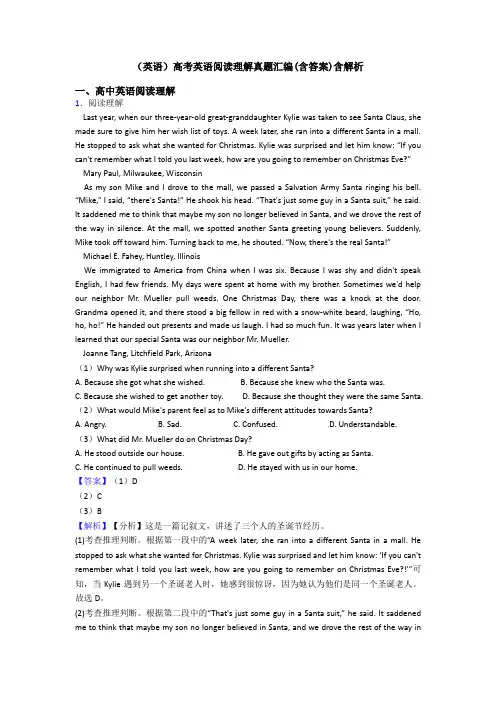
(英语)高考英语阅读理解真题汇编(含答案)含解析一、高中英语阅读理解1.阅读理解Last year, when our three-year-old great-granddaughter Kylie was taken to see Santa Claus, she made sure to give him her wish list of toys. A week later, she ran into a different Santa in a mall. He stopped t o ask what she wanted for Christmas. Kylie was surprised and let him know: “If you can't remember what I told you last week, how are you going to remember on Christmas Eve?”Mary Paul, Milwaukee, WisconsinAs my son Mike and I drove to the mall, we passed a Salvation Army Santa ringing his bell. “Mike,” I said, “there's Santa!” He shook his head. “That's just some guy in a Santa suit,” he said. It saddened me to think that maybe my son no longer believed in Santa, and we drove the rest of the way in silence. At the mall, we spotted another Santa greeting young believers. Suddenly, Mike took off toward him. Turning back to me, he shouted. “Now, there's the real Santa!”Michael E. Fahey, Huntley, IllinoisWe immigrated to America from China when I was six. Because I was shy and didn't speak English, I had few friends. My days were spent at home with my brother. Sometimes we'd help our neighbor Mr. Mueller pull weeds. One Christmas Day, there was a knock at the door. Grandma opened it, and there stood a big fellow in red with a snow-white beard, laughing, “Ho, ho, ho!” He handed out presents and made us laugh. I had so much fun. It was years later when I learned that our special Santa was our neighbor Mr. Mueller.Joanne Tang, Litchfield Park, Arizona(1)Why was Kylie surprised when running into a different Santa?A. Because she got what she wished.B. Because she knew who the Santa was.C. Because she wished to get another toy.D. Because she thought they were the same Santa.(2)What would Mike's parent feel as to Mike's different attitudes towards Santa?A. Angry.B. Sad.C. Confused.D. Understandable.(3)What did Mr. Mueller do on Christmas Day?A. He stood outside our house.B. He gave out gifts by acting as Santa.C. He continued to pull weeds.D. He stayed with us in our home.【答案】(1)D(2)C(3)B【解析】【分析】这是一篇记叙文,讲述了三个人的圣诞节经历。
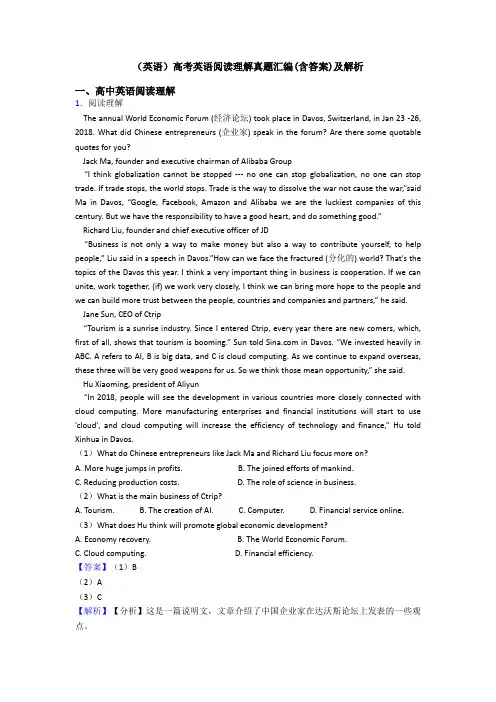
(英语)高考英语阅读理解真题汇编(含答案)及解析一、高中英语阅读理解1.阅读理解The annual World Economic Forum (经济论坛) took place in Davos, Switzerland, in Jan 23 -26, 2018. What did Chinese entrepreneurs (企业家) speak in the forum? Are there some quotable quotes for you?Jack Ma, founder and executive chairman of Alibaba Group“I think globalization cannot be stopped --- no one can stop globalization, no one can stop trade. If trade stops, the world stops. Trade is the way to dissolve the war not cause the war,”said Ma in Davos, “G oogle, Facebook, Amazon and Alibaba we are the luckiest companies of this century. But we have the responsibility to have a good heart, and do something good.”Richard Liu, founder and chief executive officer of JD“Business is not only a way to ma ke money but also a way to contribute yourself, to help people,” Liu said in a speech in Davos.”How can we face the fractured (分化的) world? That's the topics of the Davos this year. I think a very important thing in business is cooperation. If we can unite, work together, (if) we work very closely, I think we can bring more hope to the people and we can build more trust between the people, countries and companies and partners,” he said.Jane Sun, CEO of Ctrip“Tourism is a sunrise industry. Since I e ntered Ctrip, every year there are new comers, which, first of all, shows that tourism is booming.” Sun told in Davos. “We invested heavily in ABC. A refers to AI, B is big data, and C is cloud computing. As we continue to expand overseas, these t hree will be very good weapons for us. So we think those mean opportunity,” she said.Hu Xiaoming, president of Aliyun“In 2018, people will see the development in various countries more closely connected with cloud computing. More manufacturing enterprises and financial institutions will start to use 'cloud', and cloud computing will increase the efficiency of technology and finance,” Hu told Xinhua in Davos.(1)What do Chinese entrepreneurs like Jack Ma and Richard Liu focus more on?A. More huge jumps in profits.B. The joined efforts of mankind.C. Reducing production costs.D. The role of science in business.(2)What is the main business of Ctrip?A. Tourism.B. The creation of AI.C. Computer.D. Financial service online.(3)What does Hu think will promote global economic development?A. Economy recovery.B. The World Economic Forum.C. Cloud computing.D. Financial efficiency.【答案】(1)B(2)A(3)C【解析】【分析】这是一篇说明文,文章介绍了中国企业家在达沃斯论坛上发表的一些观点。

一、高中英语阅读理解1.阅读理解The new social robots, including Jibo, Cozmo, Kuri and Meccano M.A.X., bear some resemblance to assistants like Apple's Siri, but these robots come with something more. They are designed to win us over not with their smarts but with their personality. They are sold as companions that do more than talk to us. Time magazine hailed (称赞) the robots that "could fundamentally reshape how we interact with machines." But is reshaping how we interact with machines a good thing, especially for children?Some researchers in favor of the robots don't see a problem with this. People have relationships with many kinds of things. Some say robots are just another thing with which we can have relationships. To support their argument, roboticists sometimes point to how children deal with toy dolls. Children animate (赋予…生命) dolls and turn them into imaginary friends. Jibo, in a sense, will be one more imaginary friend, and arguably a more intelligent and fun one.Getting attached to dolls and sociable machines is different, though. Today's robots tell children that they have emotions, friendships, even dreams to share. In reality, the whole goal of the robots is emotional trickery. For instance, Cozmo the robot needs to be fed, repaired and played with. Boris Sofman, the chief executive of Anki, the company behind Cozmo, says that the idea is to create "a deeper and deeper emotional connection ... And if you neglect him, you feel the pain of that." What is the point of this, exactly? What does it mean to feel the pain of neglecting something that feels no pain at being neglected, or to feel anger at being neglected by something that doesn't even know it is neglecting you?This should not be our only concern. It is troubling that these robots try to empathize with children. Empathy allows us to put ourselves in the place of others, to know what they are feeling. Robots, however, have no emotions to share, and they cannot put themselves in our place. No matter what robotic creatures "say" or squeak, they don't understand our emotional lives. They present themselves as empathy machines, but they are missing the essential equipment. They have not been born, they don't know pain, or death, or fear. Robot thinking may be thinking, but robot feeling is never feeling, and robot love is never love.What is also troubling is that children take robots' behavior to indicate feelings. When the robots interact with them, children take this as evidence that the robots like them, and when robots don't work when needed, children also take it personally. Their relationships with the robots affect their self-esteem (自尊). In one study, an 8-year-old boy concluded that the robot stopped talking to him because the robot liked his brothers better.For so long, we dreamed of artificial intelligence offering us not only simple help but conversation and care. Now that our dream is becoming real, it is time to deal with the emotional downside of living with robots that "feel."(1)How are the new social robots different from Siri?A. They are intended to teach children how to talk.B. They are designed to attract people with their smarts.C. Their main function is to evaluate children's personality.D. They have a new way to communicate with human beings.(2)In Paragraph 3 Cozmo is used as an example to show that the social robots ______.A. are deeply connected with human beingsB. are unable to build a real relationship with childrenC. are so advanced that they can feel the pain of human beingsD. are not good enough to carry out the instructions of children(3)The underlined phrase "essential equipment" in Paragraph 4 refers to ______.A. emotionB. painC. fearD. thinking(4)Which of the following shows the development of ideas in the passage?I: Introduction P: Point Sp: Sub-point (次要点) C: ConclusionA. B.C. D.【答案】(1)D(2)B(3)A(4)B【解析】【分析】本文是一篇议论文,新的社交机器人与以往机器人不同,他们不仅比我们聪明还有他们的个性。
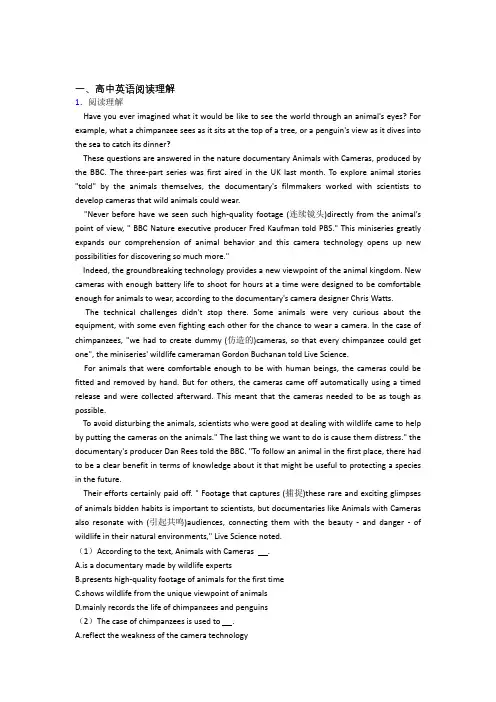
一、高中英语阅读理解1.阅读理解Have you ever imagined what it would be like to see the world through an animal's eyes? For example, what a chimpanzee sees as it sits at the top of a tree, or a penguin's view as it dives into the sea to catch its dinner?These questions are answered in the nature documentary Animals with Cameras, produced by the BBC. The three-part series was first aired in the UK last month. To explore animal stories "told" by the animals themselves, the documentary's filmmakers worked with scientists to develop cameras that wild animals could wear."Never before have we seen such high-quality footage (连续镜头)directly from the animal's point of view, " BBC Nature executive producer Fred Kaufman told PBS." This miniseries greatly expands our comprehension of animal behavior and this camera technology opens up new possibilities for discovering so much more."Indeed, the groundbreaking technology provides a new viewpoint of the animal kingdom. New cameras with enough battery life to shoot for hours at a time were designed to be comfortable enough for animals to wear, according to the documentary's camera designer Chris Watts.The technical challenges didn't stop there. Some animals were very curious about the equipment, with some even fighting each other for the chance to wear a camera. In the case of chimpanzees, "we had to create dummy (仿造的)cameras, so that every chimpanzee could get one", the miniseries' wildlife cameraman Gordon Buchanan told Live Science.For animals that were comfortable enough to be with human beings, the cameras could be fitted and removed by hand. But for others, the cameras came off automatically using a timed release and were collected afterward. This meant that the cameras needed to be as tough as possible.To avoid disturbing the animals, scientists who were good at dealing with wildlife came to help by putting the cameras on the animals." The last thing we want to do is cause them distress." the documentary's producer Dan Rees told the BBC. "To follow an animal in the first place, there had to be a clear benefit in terms of knowledge about it that might be useful to protecting a species in the future.Their efforts certainly paid off. " Footage that captures (捕捉)these rare and exciting glimpses of animals bidden habits is important to scientists, but documentaries like Animals with Cameras also resonate with (引起共鸣)audiences, connecting them with the beauty - and danger - of wildlife in their natural environments," Live Science noted.(1)According to the text, Animals with Cameras .A.is a documentary made by wildlife expertsB.presents high-quality footage of animals for the first timeC.shows wildlife from the unique viewpoint of animalsD.mainly records the life of chimpanzees and penguins(2)The case of chimpanzees is used to .A.reflect the weakness of the camera technologyB.present how filmmakers put cameras on chimpanzeesC.explain why chimpanzees were attracted by the equipmentD.show how filmmakers dealt with the challenges in shooting(3)To avoid disturbing the animals, filmmakers .A.set up a protected area for them to live inB.invited scientists to help equip them with camerasC.made the cameras look like animals in disguiseD.fitted and removed the cameras by hand(4)The author's attitude toward the documentary can be described as .A.changingB.supportiveC.cautiousD.pessimistic【答案】(1)C(2)D(3)B(4)B【解析】【分析】本文是一篇说明文,介绍了研究人员使用最新的相机技术,让人们从动物的视角看世界。
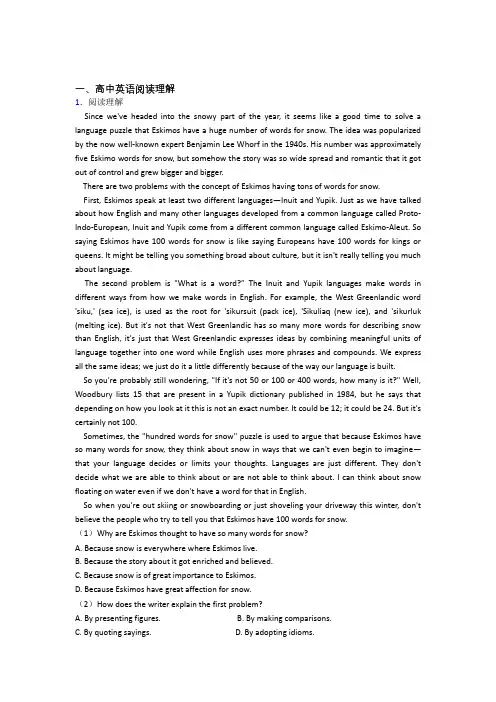
一、高中英语阅读理解1.阅读理解Since we've headed into the snowy part of the year, it seems like a good time to solve a language puzzle that Eskimos have a huge number of words for snow. The idea was popularized by the now well-known expert Benjamin Lee Whorf in the 1940s. His number was approximately five Eskimo words for snow, but somehow the story was so wide spread and romantic that it got out of control and grew bigger and bigger.There are two problems with the concept of Eskimos having tons of words for snow.First, Eskimos speak at least two different languages—Inuit and Yupik. Just as we have talked about how English and many other languages developed from a common language called Proto-Indo-European, Inuit and Yupik come from a different common language called Eskimo-Aleut. So saying Eskimos have 100 words for snow is like saying Europeans have 100 words for kings or queens. It might be telling you something broad about culture, but it isn't really telling you much about language.The second problem is "What is a word?” The Inuit and Yupik languages make words in different ways from how we make words in English. For example, the West Greenlandic word 'siku,' (sea ice), is used as the root for 'sikursuit (pack ice), 'Sikuliaq (new ice), and 'sikurluk (melting ice). But it's not that West Greenlandic has so many more words for describing snow than English, it's just that West Greenlandic expresses ideas by combining meaningful units of language together into one word while English uses more phrases and compounds. We express all the same ideas; we just do it a little differently because of the way our language is built.So you're probably still wondering, "If it's not 50 or 100 or 400 words, how many is it?" Well, Woodbury lists 15 that are present in a Yupik dictionary published in 1984, but he says that depending on how you look at it this is not an exact number. It could be 12; it could be 24. But it's certainly not 100.Sometimes, the "hundred words for snow" puzzle is used to argue that because Eskimos have so many words for snow, they think about snow in ways that we can't even begin to imagine—that your language decides or limits your thoughts. Languages are just different. They don't decide what we are able to think about or are not able to think about. I can think about snow floating on water even if we don't have a word for that in English.So when you're out skiing or snowboarding or just shoveling your driveway this winter, don't believe the people who try to tell you that Eskimos have 100 words for snow.(1)Why are Eskimos thought to have so many words for snow?A. Because snow is everywhere where Eskimos live.B. Because the story about it got enriched and believed.C. Because snow is of great importance to Eskimos.D. Because Eskimos have great affection for snow.(2)How does the writer explain the first problem?A. By presenting figures.B. By making comparisons.C. By quoting sayings.D. By adopting idioms.(3)The example of the west Greenlandic word 'siku' shows that .A. the making of words varies from language to languageB. the Inuit and Yupik languages have more words for snowC. the richness of words and phrases leads to different ideasD. more phrases about snow are found in the English language(4)What conclusion can we safely draw from the last two paragraphs?A. Eskimos better understand snow than other people.B. Languages deeply influence people's ability to think.C. There is no point counting Eskimo's expressions for snow.D. What comes into our mind is limited by our language.【答案】(1)B(2)B(3)A(4)C【解析】【分析】本文是一篇说明文,介绍了爱斯基摩人描述雪的词语虽然多但并非传言中的100多个。
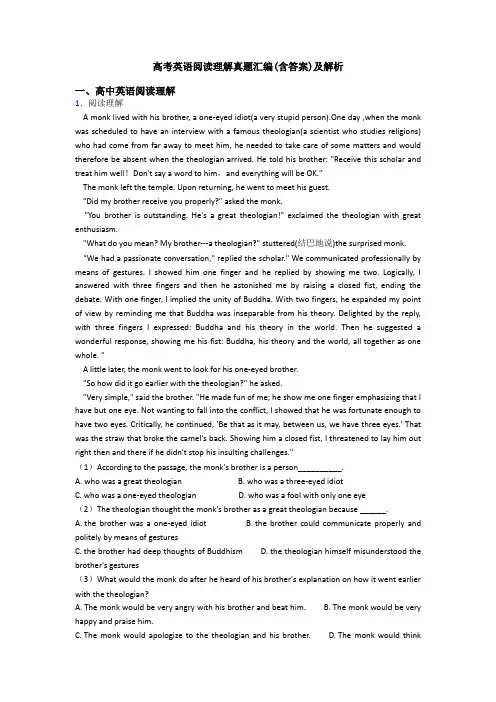
高考英语阅读理解真题汇编(含答案)及解析一、高中英语阅读理解1.阅读理解A monk lived with his brother, a one-eyed idiot(a very stupid person).One day ,when the monk was scheduled to have an interview with a famous theologian(a scientist who studies religions) who had come from far away to meet him, he needed to take care of some matters and would therefore be absent when the theologian arrived. He told his brother: "Receive this scholar and treat him well!Don't say a word to him,and everything will be OK."The monk left the temple. Upon returning, he went to meet his guest."Did my brother receive you properly?" asked the monk."You brother is outstanding. He's a great theologian!" exclaimed the theologian with great enthusiasm."What do you mean? My brother---a theologian?" stuttered(结巴地说)the surprised monk."We had a passionate conversation," replied the scholar." We communicated professionally by means of gestures. I showed him one finger and he replied by showing me two. Logically, I answered with three fingers and then he astonished me by raising a closed fist, ending the debate. With one finger, I implied the unity of Buddha. With two fingers, he expanded my point of view by reminding me that Buddha was inseparable from his theory. Delighted by the reply, with three fingers I expressed: Buddha and his theory in the world. Then he suggested a wonderful response, showing me his fist: Buddha, his theory and the world, all together as one whole. "A little later, the monk went to look for his one-eyed brother."So how did it go earlier with the theologian?" he asked."Very simple," said the brother. "He made fun of me; he show me one finger emphasizing that I have but one eye. Not wanting to fall into the conflict, I showed that he was fortunate enough to have two eyes. Critically, he continued, 'Be that as it may, between us, we have three eyes.' That was the straw that broke the camel's back. Showing him a closed fist, I threatened to lay him out right then and there if he didn't stop his insulting challenges."(1)According to the passage, the monk's brother is a person__________.A. who was a great theologianB. who was a three-eyed idiotC. who was a one-eyed theologianD. who was a fool with only one eye(2)The theologian thought the monk's brother as a great theologian because ______. A. the brother was a one-eyed idiot B. the brother could communicate properly and politely by means of gesturesC. the brother had deep thoughts of BuddhismD. the theologian himself misunderstood the brother's gestures(3)What would the monk do after he heard of his brother's explanation on how it went earlier with the theologian?A. The monk would be very angry with his brother and beat him.B. The monk would be very happy and praise him.C. The monk would apologize to the theologian and his brother.D. The monk would thinkwhat a funny misunderstanding it was.(4)According to what the theologian said, he considered the monk's brother's fist to be the meaning of _____________.A. a threat to himB. an encouragement to himC. a unity of the Buddha, theory and the worldD. one eye of himself【答案】(1)D(2)D(3)D(4)C【解析】【分析】本文是一篇记叙文,神学大师站在自己的角度误解了和尚的傻瓜弟弟的手势语言,让人读着忍不住发笑。
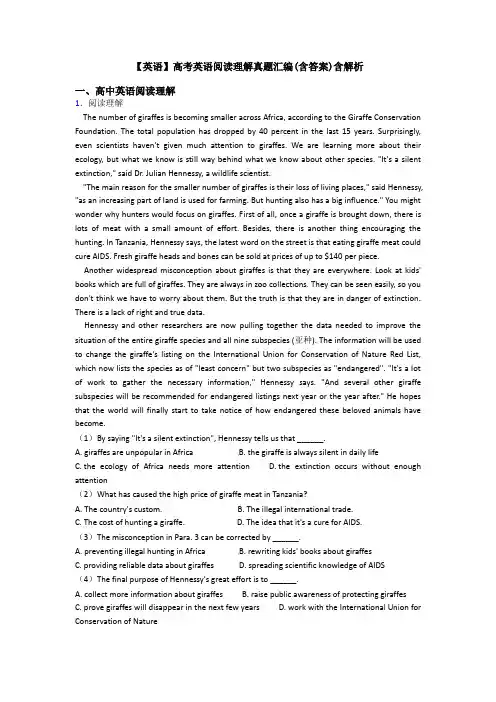
【英语】高考英语阅读理解真题汇编(含答案)含解析一、高中英语阅读理解1.阅读理解The number of giraffes is becoming smaller across Africa, according to the Giraffe Conservation Foundation. The total population has dropped by 40 percent in the last 15 years. Surprisingly, even scientists haven't given much attention to giraffes. We are learning more about their ecology, but what we know is still way behind what we know about other species. "It's a silent extinction," said Dr. Julian Hennessy, a wildlife scientist."The main reason for the smaller number of giraffes is their loss of living places," said Hennessy, "as an increasing part of land is used for farming. But hunting also has a big influence." You might wonder why hunters would focus on giraffes. First of all, once a giraffe is brought down, there is lots of meat with a small amount of effort. Besides, there is another thing encouraging the hunting. In Tanzania, Hennessy says, the latest word on the street is that eating giraffe meat could cure AIDS. Fresh giraffe heads and bones can be sold at prices of up to $140 per piece.Another widespread misconception about giraffes is that they are everywhere. Look at kids' books which are full of giraffes. They are always in zoo collections. They can be seen easily, so you don't think we have to worry about them. But the truth is that they are in danger of extinction. There is a lack of right and true data.Hennessy and other researchers are now pulling together the data needed to improve the situation of the entire giraffe species and all nine subspecies (亚种). The information will be used to change the giraffe's listing on the International Union for Conservation of Nature Red List, which now lists the species as of "least concern" but two subspecies as "endangered". "It's a lot of work to gather the necessary information," Hennessy says. "And several other giraffe subspecies will be recommended for endangered listings next year or the year after." He hopes that the world will finally start to take notice of how endangered these beloved animals have become.(1)By saying "It's a silent extinction", Hennessy tells us that ______.A. giraffes are unpopular in AfricaB. the giraffe is always silent in daily lifeC. the ecology of Africa needs more attentionD. the extinction occurs without enough attention(2)What has caused the high price of giraffe meat in Tanzania?A. The country's custom.B. The illegal international trade.C. The cost of hunting a giraffe.D. The idea that it's a cure for AIDS.(3)The misconception in Para. 3 can be corrected by ______.A. preventing illegal hunting in AfricaB. rewriting kids' books about giraffesC. providing reliable data about giraffesD. spreading scientific knowledge of AIDS(4)The final purpose of Hennessy's great effort is to ______.A. collect more information about giraffesB. raise public awareness of protecting giraffesC. prove giraffes will disappear in the next few yearsD. work with the International Union for Conservation of Nature【答案】(1)D(2)D(3)C(4)B【解析】【分析】本文是一篇说明文,介绍了长颈鹿濒临灭绝的原因,并指出提供准确的数据,提高人们的保护意识至关重要。
【英语】高考英语阅读理解题20套(带答案)及解析一、高中英语阅读理解1.阅读下列短文,从短文后每题所给的A、B、C和D四个选项中,选出最佳选项。
A new technology is going to ripe, one that could transform our daily lives, help to form new industries, even remove world economic powers from their present positions. Unlike the wave of industrialization that began in the West and spread later to the rest of the world, the new developments are taking place in research labs all over the globe—and Asians are in the forefront. Physicists are creating a new class of materials that display an amazing property unforeseen even two years ago—superconductivity (超导体技术).Used today only in specialized equipment, super conductors have the potential to radically change most of the electrical and electronic appliances found in the home, making them smaller, more powerful and efficient. They could free our cities of pollution by replacing petrol and diesel (柴油) vehicles with electric cars, and cut the cost of electricity. The new materials do something that even the best of conductors such as copper and silver cannot—they do away with all electrical resistance. The significances for energy storage are great.The technology is in its early stage, still accessible to countries that decide to invest brains and money. For 75 years it had remained little more than a scientific curiosity with limited practical use because the phenomenon occurred only at extremely low temperatures. It was first observed in 1911 by a Dutch scientist named Heike Kamerlingh Onnes, who cooled mercury (水银) to temperatures below -269℃ with liquid helium (氦). Then in January last year, two IBM scientists, K. Alex Muller and J. George Bednorz, found a metal oxide ceramic (氧化陶瓷) that superconducted at -243℃. Their report went largely unnoticed until last December, when it was confirmed at a scientific meeting in Boston. Today Japan, India, China and other Asian countries all have their share of experts who spend their days and nights in labs, acting as midwives (助产士) to a new technology.(1)As is indicated in the passage, the technology of superconductivity ____________. A. has already been developed B. is still under developmentC. will be used only in specialized equipmentD. will be used in daily lives in a few years(2)The new technology differs from the others in that ____________.A. it began in the East and spread later to the rest of the worldB. it began in the West and spread later to the rest of the worldC. it is being cultivated in research labs around the worldD. it is accessible to physicists who are intelligent and rich(3)From the passage, we may conclude that ____________.A. Asian scientists gain the lead in the growth of the new technologyB. Dutch scientists kept reporting new findings for the last 75 yearsC. IBM scientists' report receive immediate attention all over the worldD. the West was astonished at the new technology developed by the Asians(4)Which of the following would be the best title for the passage?A. The Prospect of a New TechnologyB. Superconductivity: A New TechnologyC. A New Technology: The Key to Change the Way of Our LivesD. A New Technology: A Joint Effort of Many Countries【答案】(1)B(2)C(3)A(4)B【解析】【分析】本文是一篇说明文,介绍了超导体技术的发展潜能和发展状况。
一、高中英语阅读理解1.阅读理解A dog spent the last four years of his life waiting a crossroad in the Thai city of Khon Kaen as if waiting for someone. People originally thought the dog had been abandoned, but then realized that he looked healthy, so people asked around about him. It turned out that the dog had indeed been spending most of his time around that crossroad, but a woman had been coming -.round regularly to bring him food and water.One day, while photographing the dog everyone called Leo, a reporter met the woman who had been taking care of him. She had come to drop off some food. After learning the story about the dog and the woman, the reporter decided to share the story on social media. The post soon went viral and the photos of Leo got shared hundreds of times. And the photos reached the eyes of Leo^ former old owner.Nang Noi Sittisarn, a 64-year-old woman from Thailand's Roi Et Province, almost had a heart attack when her daughter showed her a photo of the beloved dog named BonBon she had lost during a car trip. When she learned that he had been waiting for her in the same spot for the last four years,her heart melted(融化).Auntie Noi told her daughter to drive her to where the dog was waiting. When she got there and called his name. BonBon, the poor dog started wiggling(扭动)his tail and came to her,but when she tried to take him home with her, he was unwilling to follow. She didn't want to force the dog to come with her so she agreed to leave him with his new master. However, she and her daughter will come to visit him regularly.(1)Why did the dog look healthy after separation from his former owner?A.He walked around the crossroad constantly.B.He was kept at a woman's home all the time.C.A local reporter brought him food and water.D.A woman looked after him on a regular basis.(2)What does the underlined phrase "went viral" in paragraph 2 probably mean?A.Changed surprisingly.B.Spread quickly.C.Appeared gradually.D.Fell directly.(3)How did Nang Noi Sittisam feel about the dog's waiting for her?A.Shocked.B.Regretful.C.Touched.D.Proud(4)What can we mainly learn from the story about the dog?A.Unbelievable success is worth waiting for.B.We should adjust ourselves to environments.C.We need to learn to be faithful and thankful.D.No one knows the result until the last minute.【答案】(1)D(2)A(3)C(4)C【解析】【分析】本文是一篇记叙文。
近十年全国高考英语阅读理解真题汇编(WORD版本真题试卷+名师详细解析答案)(约900页阅读理解专项练题,值得下载练习)第1题普通高等学校夏季招生考试英语(全国Ⅱ)BSome people have the feeling that nothing can be done about their poor reading ability(能力). They feel hopeless about it. Can you learn to read better or must you agree that nothing can be done about it?To be sure, people are different. You cannot to do everything as well as certain other people do. It al thestudents in a class tried out for basketball, some would be very good players; others would be very poor; and many would be in between. But even the very poor players can become much better players if they are guided in the right way, and with plenty of practice. It is the same with reading. Some seem to enjoy reading and to read well withoutany special help. Others find reading a slow and tiring job. In between, there are all degrees of reading ability.Many experiments have shown that just about every poor reader can improve his reading ability. In these experiments, the poor readers were given tests of reading ability After some of the causes of their poor readingwere discovered, they were given special instruction and practice in reading. After a few months, another test of the same kind was given. In nearly all cases, these people had raised their reading scores.46. With the example of basketball players, the author shows_________.A. why certain people are poor readersB. that there are differences in people‘s abilitiesC. why some people are good basketball playersD. that good basketball players can be good readers47.To improve their reading ability, people should ________.A. work long and hardB. take different forms of testsC. have special help and practiceD. try different reading materials48. The experiments mentioned in the text show that _________.A. good readers seem to enjoy readingB. almost all poor readers can make progressC. causes of poor reading are difficult to find outD. tests help people improve their reading ability答案46. B解析:这是一道归纳题。
高考英语阅读理解真题汇编(含答案)含解析一、高中英语阅读理解1.阅读理解Michele Gentile, an Italian bookseller, is offering free books to children in exchange for plastic bottles to recycle.Michele owns Ex Libris Cafe in Polla, a small town in southern Italy. He said he thought of the recycling program because he wanted to inspire children in the small town to read and pay attention to the environment."My goal is t0 spread the passion and love for books among those people in Italy who do not usually read while at the time helping the environment," Gentile explained.The idea for the initiative (倡议) came after Gentile collaborated with a nearby middle school on an aluminum recycling project. Working together, the schoolchildren and Gentile collected enough cans to purchase books for an entire classroom. His new program too off from there and has already spread into northern Italy: Gentile's hopes his work will continue to make headlines and become a worldwide initiative.The free books come from customers in Gentile's shop who have donated money to purchase a "suspended" book. The idea comes from a World War II practice in which customers would buy two Coffees: one for themselves and another for the next person in line. Gentile has been using the extra books as part of his recycling initiative,While Gentile's program is a great way to recycle and get kids to read, it also brings awareness to the growing problem of plastic waste. Single-use plastics make up around 26 percent of all the plastics in the world, only 14 percent of which are recycled. Plastics that end up in landfills take around 500 years to decompose (分解), is a major concern for environmentalists.Cutting down on plastic waste is important if we want to better the environment for future generations, and recycling programs like Gentile's book giveaway are a great way to meet that goal.(1)What is the purpose of Gentile's book giveaway?A.To sell more coffee and books.B.To attract more customers.C.To collect money for a new project.D.To inspire reading and recycling.(2)How did Gentile come up with the idea?A.Working with a school to recycle cans.B.Seeing school kids don't like reading.C.Donating books for a local school.D.Buying a “suspended” book for a child.(3)Who pay for the books of the project?A.The local government.B.Gentile himself.C.Some publishers.D.His customers.(4)Which of the following is the best title for the text?A.An Italian's Reading InitiativeB.Recycling Can Get Kids Free BooksC.Michele's Way of Doing BusinessD.A New Way to Deal with Plastic Waste【答案】(1)D(2)A(3)D(4)B【解析】【分析】本文是一篇记叙文,意大利书商Michele Gentile发起了一项“拿瓶换书”的活动,只要孩子们拿一个塑料瓶和一个铝罐就可以跟他换一本书,以此来鼓励孩子们阅读和环保。
高考英语阅读理解综合题附答案解析一、高中英语阅读理解1.阅读理解FaceApp has taken the world by storm, giving users the chance to see themselves age through its algorithm. 12.7 million people—some three million more than the population of New York City—reportedly downloaded it in one seven-day period last month.Although the Russian app has become known for its privacy issues, the more interesting lesson of our FaceApp fling (尽情玩乐)is what it tells us about our society—and our future lives. It turns out we are more interested in aging than we realized. I'm surprised by this. Most younger people are in denial (否认)about old age, doing almost nothing to prepare for it. We rarely have a chance to plan for the future, with increasing time and financial pressures. Those pressures bring sacrifices that we may not always want to make: we can no longer afford to spend the time or the money needed to look after our elderly parents.As a family doctor, I can see the loneliness epidemic developing. Elderly patients come to see me with no particular illness, no clear medical issue. After a few minutes of the consultation, I understand why: they're not sick, and often they don't feel sick. They just need someone—anyone-to talk to.Although loneliness has no medical classification, the health effects are real: the result of loneliness and isolation can be as harmful to our health as smoking 15 cigarettes a day, and is more damaging than obesity. But loneliness does not come with nearly enough health warnings. So what next? Since 1980, we are living on average 10 years longer. At the same time, people are havingfewer and fewer children, and they are having them much later in life. The snake of a world class health service is eating its own tail; its care is prolonging (延长) people's lives, but as the ratio of pensioners(退休人员)to working -age people increases, there are fewer taxpayers to fund that very health service.Into this void have stepped NGOs, charities and volunteers. But in the long term, the only way to truly help the oldest meters of our society is to go back to the traditional values of intergenerational(两代间的) cooperation—often under same roof. Ultimately, we will need to evolve towards a culture where elderly care is treated the same as childcare, where employers recognize the duty of someone with an elderly parent the same way they recognize those of someone with a newborn child.(1)The example of FaceApp is used to _____.A. prove the popularity of itB. explain the function of itC. show the progress of technologyD. introduce the topic of aging and loneliness(2)What makes elderly people without illness go to see their family doctors?A. Desire to have the consultation.B. Strong feeling of loneliness.C. Unclear medical issues.D. Questions to ask doctors.(3)How can the oldest members be truly helped?A. By being treated as children.B. By going back to the traditional society.C. By providing family care.D. By living with other elderly people under the same roof.(4)What can we learn from the passage?A. The loneliness of elderly people needs more attention.B. FaceApp's popularity proves it has no security problems.C. Health service lacks fund because of prolonged peopled lives.D. FaceApp is helpful in dealing with elderly peopled loneliness.【答案】(1)D(2)B(3)C(4)A【解析】【分析】本文是一篇议论文,作者由FaceApp话题谈到当今的社会现象——老人感到孤独,他们需要关注。
高考英语阅读理解真题汇编(含答案)一、高中英语阅读理解1.阅读理解Mexico sites on an island plateau (高原) surrounded by volcanic peaks, which makes air quality a constant concern for people who live there.In April, the country took a decisive step toward improving air quality by enacting a temporary ban on private and Federal vehicles in the city. The rule forbids people from driving in the city one day each week and one Saturday each month. Electric vehicles, government service vehicles, public transport options and school buses are not included in the ban.Mexico City isn't the first urban center to be involved in car-free living. But the ban is more than an awareness-raiser. It was enacted with the direct aim of solving air pollution. In March, the city sank into a deep brown haze of smog when the pollution levels passed the 200 mark. The city ordered some 1.1m of the area's 4.7m cars off the streets and also offered free bus and subway rides.Mexico City's temporary vehicle ban raises questions about the best ways to improve urban air quality. India, whose citizens breathe some of the world's dirtiest air, has tried a variety of solutions. Earlier this year, the Indian government started a 4% sales tax on new-car purchases. Beijing also has experience with cleaning the air. The city introduced alternate-day rules in advance of the 2008 Olympic Games, which produced good results. And then there is the London congestion (拥挤) charge, introduced in 2003. The charge has had a measurable effect on air quality.For now, Mexico City — named by the United Nations as the most polluted city on the planet in 1992 — can look forward to the start of the region's rainy season, when daily showers will help lo clean the air.(1)How did Mexico ban vehicles in the city?A. By banning private and Federal vehicles one day a week.B. By forbidding private and public vehicles every Saturday.C. By limiting the number of new cars.D. By prohibiting the vehicles except public ones.(2)What did the government of Mexico do when carrying out the ban on vehicles?A. Raised the number of public vehicles.B. Offered free bus and subway rides.C. Introduced more travel options.D. Encouraged citizens to leave the city.(3)What may contribute to improving the air quality in Mexico?A. Alternate-day rules.B. Tax rises.C. Congestion charge.D. The rainy season.(4)What's the best title for the passage?A. Mexico —an Island PlateauB. A Variety of Bans on Vehicles in MexicoC. Should Cities Be Car-free ZonesD. How to Improve Air Quality【答案】(1)A(2)B(3)D(4)C【解析】【分析】本文是一篇说明文,墨西哥墨西哥政府为了提高空气质量,在实施车辆禁令时提供免费巴士和地铁。
一、高中英语阅读理解1.阅读理解By analyzing the fossilized teeth of some of our most ancient ancestors, a team of scientists led by the universities of Bristol (UK) and Lyon (France) have discovered that the first humans significantly breastfed their infants (婴儿) for longer periods than their contemporary relatives.The results, published in the journal Science Advances, provide a first insight into the practice of weaning (断奶)that remain otherwise unseen in the fossil record.The team sampled minute amounts from nearly 40 fossilized teeth of our South African fossil relatives, early Homo, Paranthropus robustus and Australopithecus africanus. They measured the proportions of their stable calcium isotopes (同位素)in the tooth enamel(牙釉质), which are a function of the mother milk intake by infants. They show that early Homo offspring(后代) was breastfed in significant proportions until the age of around three to four years, which likely played a role in the apparition of traits that are specific to human lineage(血统), such as the brain development.In contrast, infants of Paranthropus robustus, that became extinct around one million years ago and were a more robust species in terms of dental anatomy, as well as infants of Australopithecus africanus, stopped drinking sizeable proportions of mother milk in the course of the first months of life.These differences in nursing behaviors likely come with major changes in the social structures of groups as well as the time between the birth of one child and the birth of the next.One of the study's lead authors, Dr Theo Tacail said: "The practice of weaning -- the duration of breastfeeding, age at non-milk food introduction and the age at cessation of suckling -- differs among the modern members of the hominid family which includes humans and modern great apes: orangutan, gorillas, chimpanzees and bonobos.The development of such behavioral differences likely played major roles in the evolution of the members of human lineage, being associated for instance with size and structure of social groups, brain development.However, getting insights into these behavioral changes from fossils that are millions of years old is a challenge and, so far, little evidence allow discussing nursing practices in these fossil species.The findings stress the need for further exploration of calcium stables isotopes compositions in the fossil record in order to understand the co-evolution of weaning practices with other traits such as brain size or social behaviors."/first-human-ancestors-breastfed-for-longer-than-contemporary-relatives/https:///releases/2019/08/190829115427.htm(1)What do we know the findings of the team?A. It takes the lead in focusing on Practice weaning.B. It has disclosed the link between the weaning practice and other traits.C. It is evident that nursing practice is associated with behavioral changes.D. It's contemporary humans that spend more time breastfeeding their infants.(2)What does the underlined phrase "such behavioral differences" in Paragraph 7 most probably refer to?A. Differences in the calcium isotope in the teeth.B. Differences in the social structure of groups.C. Differences in the practice of weaning.D. Differences in the change of behaviors.(3)What does the passage mainly talk about?A. The evolution of human lineage.B. The possible influence of nursing behaviors.C. The exploration of compositions in the fossil.D. The function of mother milk at the age of infants.【答案】(1)A(2)C(3)B【解析】【分析】本文是一篇说明文,通过对祖先牙齿化石的研究,科学家们发现第一批用母乳喂养婴儿的人类比同时代的其他的近亲在时间上要长很多,而这种育幼差异可能在人类进化中扮演了重要角色,比如大脑发育和社会群体方面。
(1)考查细节理解。
根据第二段中的“The results, published in the journal Science Advances, provide a first insight in to the practice of weaning ”可知这项研究结果发表在《科学进展》杂志上,为断奶行为提供了第一手资料,而这在化石记录中是看不到的。
故选A。
(2)考查句义猜测。
根据第六段中的“The practice of weaning -- the duration of breastfeeding, age at non-milk food introduction and the age at cessation of suckling -- differs among the modern members of the hominid family which includes humans and modern great apes: orangutan, gorillas, chimpanzees and bonobos.”可知现代人和古代人的断奶行为不同,而且人类和猩猩以及猿猴在断奶的时间上是不同的,即不同时代/不同物种的断奶行为是有差异的,而画线部分的such 就是指上文提到的内容。
故选C。
(3)考查主旨大意。
根据第七段中的“The development of such behavioral differences … in the evolution of the members of human lineage, being associated for instance with size and structure of social groups, brain development.”可知,这种行为差异的发展可能在人类血统成员的进化中扮演了重要角色,例如与社会群体的大小和结构,大脑的发展有关。